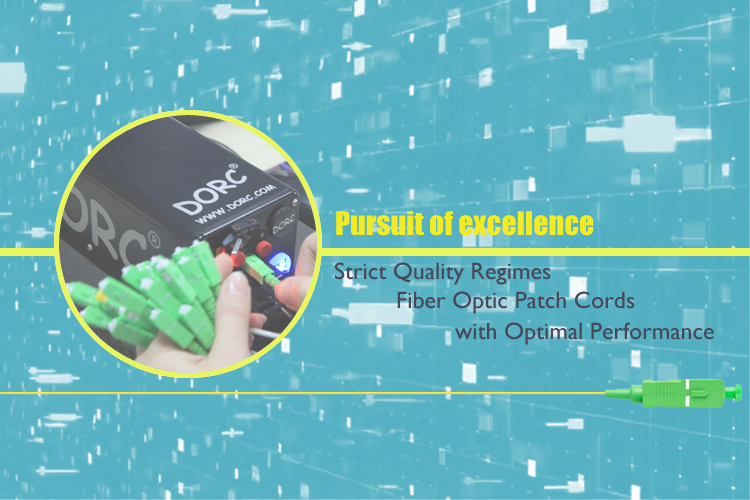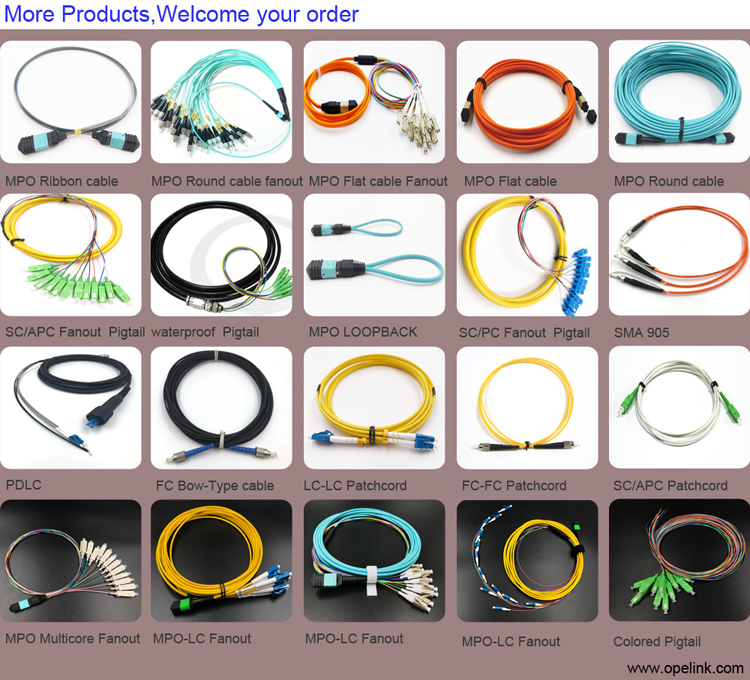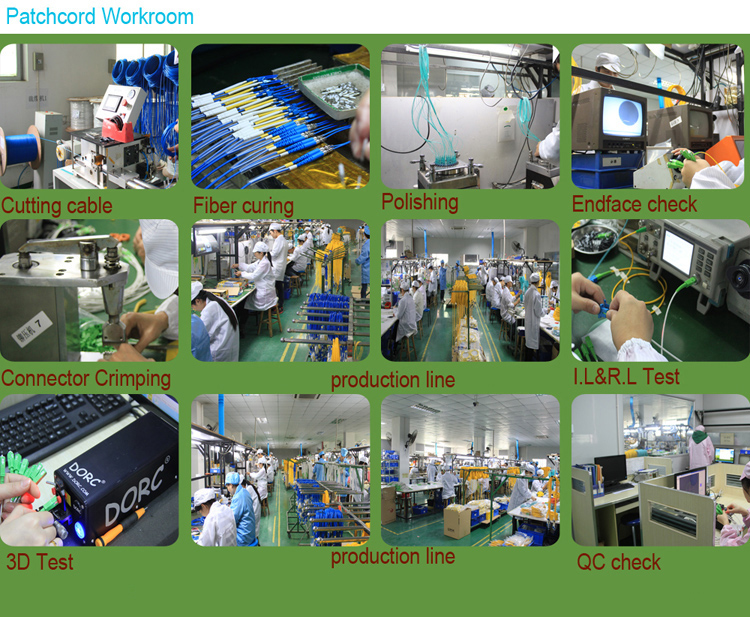By goodvin | 02 April 2024 | 0 Comments
Pursuit of excellence:Strict Quality Regimes Fiber Optic Patch Cords with Optimal Performance
Fiber optic patch cords are an essential component of any fiber optic network. They are used to connect different devices, such as switches, routers, and servers, to transmit data over long distances. The quality of these patch cords is critical to the performance of the network. In this article, we will discuss the quality assurance of fiber optic patch cords.

1. Introduction to Fiber Optic Patch Cords
Fiber optic patch cords are also known as fiber optic jumpers or fiber optic patch cables. They are used to connect two devices, such as a switch and a server, or a router and a switch. The patch cord consists of two connectors, one at each end, and a fiber optic cable that connects them. The connectors can be of different types, such as SC, LC, ST, or FC, depending on the devices they are connecting.
The fiber optic cable used in patch cords is made of glass or plastic fibers that transmit light signals. The quality of the fiber optic cable is critical to the performance of the patch cord. The cable must be able to transmit light signals over long distances without attenuation or distortion.

2. Quality Assurance of Fiber Optic Patch Cords
The quality assurance of fiber optic patch cords involves several steps, including design, manufacturing, testing, and inspection. Each step is critical to ensuring the quality of the patch cord.
2.1 Design
The design of the patch cord is critical to its performance. The design must take into account the type of connectors, the length of the cable, and the type of fiber optic cable used. The design must also ensure that the patch cord meets the required standards, such as the TIA/EIA-568-B.3 standard for fiber optic cabling.
2.2 Manufacturing
The manufacturing of the patch cord involves several steps, including cutting the fiber optic cable to the required length, polishing the connectors, and assembling the patch cord. The manufacturing process must be carried out in a clean and controlled environment to prevent contamination of the fiber optic cable.
2.3 Testing
The testing of the patch cord is critical to ensuring its quality. The patch cord must be tested for attenuation, insertion loss, return loss, and other parameters to ensure that it meets the required standards. The testing must be carried out using calibrated equipment and in accordance with the relevant standards.
2.4 Inspection
The inspection of the patch cord is critical to ensuring its quality. The patch cord must be inspected for defects, such as scratches, cracks, or contamination, that can affect its performance. The inspection must be carried out using a microscope or other suitable equipment.

3. Standards for Fiber Optic Patch Cords
There are several standards for fiber optic patch cords, including the TIA/EIA-568-B.3 standard for fiber optic cabling, the IEC 61753-1 standard for fiber optic connector interfaces, and the IEC 61300-3-35 standard for fiber optic connector end-face geometry. These standards define the requirements for the design, manufacturing, testing, and inspection of fiber optic patch cords.
4. Benefits of Quality Assurance for Fiber Optic Patch Cords
The quality assurance of fiber optic patch cords has several benefits, including:
.Improved performance: High-quality patch cords ensure that the network performs at its best, with minimal attenuation or distortion.
.Increased reliability: High-quality patch cords are less likely to fail, reducing downtime and maintenance costs.
.Compliance with standards: High-quality patch cords meet the required standards, ensuring that the network is compliant with regulations and industry best practices.
.Customer satisfaction: High-quality patch cords ensure that customers are satisfied with the performance of the network, leading to repeat business and positive reviews.
.Cost savings: High-quality patch cords reduce the need for maintenance and replacement, leading to cost savings over the long term.
5. Conclusion
The quality assurance of fiber optic patch cords is critical to the performance of any fiber optic network. The design, manufacturing, testing, and inspection of patch cords must be carried out in accordance with the relevant standards to ensure their quality. High-quality patch cords offer several benefits, including improved performance, increased reliability, compliance with standards, customer satisfaction, and cost savings. By ensuring the quality of fiber optic patch cords, network operators can ensure that their networks perform at their best, with minimal downtime and maintenance costs.
Keywords: Fiber optic Patch cord, Quality assurance, Insertion loss, Optical continuity, Temperature cycling

1. Introduction to Fiber Optic Patch Cords
Fiber optic patch cords are also known as fiber optic jumpers or fiber optic patch cables. They are used to connect two devices, such as a switch and a server, or a router and a switch. The patch cord consists of two connectors, one at each end, and a fiber optic cable that connects them. The connectors can be of different types, such as SC, LC, ST, or FC, depending on the devices they are connecting.
The fiber optic cable used in patch cords is made of glass or plastic fibers that transmit light signals. The quality of the fiber optic cable is critical to the performance of the patch cord. The cable must be able to transmit light signals over long distances without attenuation or distortion.

2. Quality Assurance of Fiber Optic Patch Cords
The quality assurance of fiber optic patch cords involves several steps, including design, manufacturing, testing, and inspection. Each step is critical to ensuring the quality of the patch cord.
2.1 Design
The design of the patch cord is critical to its performance. The design must take into account the type of connectors, the length of the cable, and the type of fiber optic cable used. The design must also ensure that the patch cord meets the required standards, such as the TIA/EIA-568-B.3 standard for fiber optic cabling.
2.2 Manufacturing
The manufacturing of the patch cord involves several steps, including cutting the fiber optic cable to the required length, polishing the connectors, and assembling the patch cord. The manufacturing process must be carried out in a clean and controlled environment to prevent contamination of the fiber optic cable.
2.3 Testing
The testing of the patch cord is critical to ensuring its quality. The patch cord must be tested for attenuation, insertion loss, return loss, and other parameters to ensure that it meets the required standards. The testing must be carried out using calibrated equipment and in accordance with the relevant standards.
2.4 Inspection
The inspection of the patch cord is critical to ensuring its quality. The patch cord must be inspected for defects, such as scratches, cracks, or contamination, that can affect its performance. The inspection must be carried out using a microscope or other suitable equipment.

3. Standards for Fiber Optic Patch Cords
There are several standards for fiber optic patch cords, including the TIA/EIA-568-B.3 standard for fiber optic cabling, the IEC 61753-1 standard for fiber optic connector interfaces, and the IEC 61300-3-35 standard for fiber optic connector end-face geometry. These standards define the requirements for the design, manufacturing, testing, and inspection of fiber optic patch cords.
4. Benefits of Quality Assurance for Fiber Optic Patch Cords
The quality assurance of fiber optic patch cords has several benefits, including:
.Improved performance: High-quality patch cords ensure that the network performs at its best, with minimal attenuation or distortion.
.Increased reliability: High-quality patch cords are less likely to fail, reducing downtime and maintenance costs.
.Compliance with standards: High-quality patch cords meet the required standards, ensuring that the network is compliant with regulations and industry best practices.
.Customer satisfaction: High-quality patch cords ensure that customers are satisfied with the performance of the network, leading to repeat business and positive reviews.
.Cost savings: High-quality patch cords reduce the need for maintenance and replacement, leading to cost savings over the long term.
5. Conclusion
The quality assurance of fiber optic patch cords is critical to the performance of any fiber optic network. The design, manufacturing, testing, and inspection of patch cords must be carried out in accordance with the relevant standards to ensure their quality. High-quality patch cords offer several benefits, including improved performance, increased reliability, compliance with standards, customer satisfaction, and cost savings. By ensuring the quality of fiber optic patch cords, network operators can ensure that their networks perform at their best, with minimal downtime and maintenance costs.
Keywords: Fiber optic Patch cord, Quality assurance, Insertion loss, Optical continuity, Temperature cycling
Leave a Reply
Your email address will not be published.Required fields are marked. *
POPULAR BLOG
- Guide to the Construction of Optical Fiber Cable Factories
- The Future of Fiber Optic Access Networks: An Expert Perspective
- Market Analysis of Fiber Optic Testing Equipment: Key Trends and Insights
- Will SDM Technology Become the Only Way for High-Capacity Optical Transmission?
- Fiber Optic Network Development Strategy and Technical Roadmap